
North Gaulton Castle, Orkney
Saturday 23rd July 2017
Saturday 23rd July 2017
 Weather/Conditions: Dry overcast summer weather. Slight swell in the sea making landing on the Original Route impractical - the swell was less on the seaward side though.
Weather/Conditions: Dry overcast summer weather. Slight swell in the sea making landing on the Original Route impractical - the swell was less on the seaward side though.
Distance/Ascent/Time: 0.1km / 40m - but 'hill' stats a bit contrived here, really...
Accompanying: Dave & the Zawadski's
As such, I make no apology for the long account!
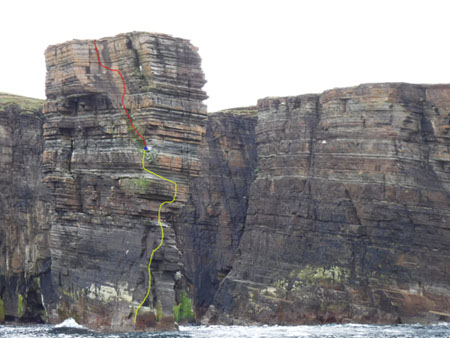
Richard, along with Will and company, picked us up from our B&B near Stromness and drove us down to the harbour. Our transport for the day was Teal, a little boat backed up by a smaller inflatable, should we need it.
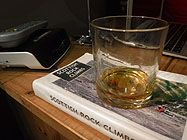
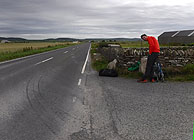
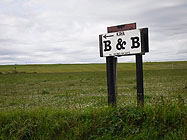
Approach and Scoping Routes
We sailed out of Stromness Harbour and into the exposed coast south of Yesnaby. Sandstone cliffs abound here with not one route. We sailed north and in time the Castle came into view, seen as a wafer of sandstone set in front of an ampitheatre of cliffs. We sailed closer searching out the line of Original Route, a set of corner grooves running up the SE corner of the stack.
As far as I can ascertain, all previous ascents have sought out these corners by (sometimes markedly) varying lines. I am aware there may have been unrecorded climbing by certain parties in the past, though I've heard nothing more than vague allusions.
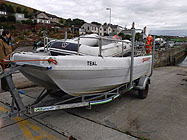
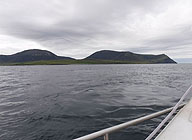
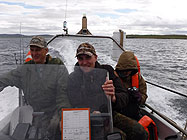

We sailed around the stack, and our first port of call was the Original Route. At this time the tide was up, with the swell a touch greater than forecast. It became clear that the base of the Original Route was wet, and there was no suitable landing place for us here.
We pulled back from this option and thought about alternatives. We looked at other lines, relying on instinct and experience to find a line rather than a guidebook description and grade. At this point we also faced the prospect of failing completely if there were no viable options. I had to remind Dave of this when a moment of optimism lept and bound away with itself.
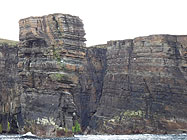
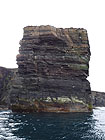
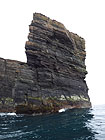
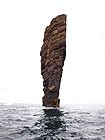
Richard was fantastic too, encouraging mental space and time to think about any choices. The swell was a lot less marked on the seaward side, and this presented an opportunity for landing. We looked at options on the SW flank, but options seemed to run into dead ends and the upper flanks seemed to turn to rubble.
There was, however, an option on the NW side: a low ledge onto which we could jump, a set off roofs leading to a corner groove which twisted up and left to the summit. I told Dave straight off that I could 'imagine' climbing the lower half. I could 'see' it. But oddly I could not 'see' the upper half in the same way. He said he felt the opposite, and with that we decided that if I took pitch one and he took pitch two, then the game was on.
Take a moment to think. Then commit.
Climbing
We sorted gear and tied into ropes, the action of which caused me to throw up over the side of the boat at least four or five times. I went from feeling like death to reasonable within a moment!
When ready, Richard powered the boat up and took it to the foot of the stack. Dave went first, having one attempt (which nearly ended in a crushed ankle) before nailing it on the second attempt. He took in the ropes then I went myself: Richard rammed the boat against the stack, the swell pushed the boat high, and I jumped and held the ledge, keeping feet steady on the rock to pull up and meet Dave.
We were on the stack, and I was first to lead. Dave took the rucksack, and I sorted myself a final time. The Zawadski's headed off on the boat, watching for the first while before eventually disappearing off to fish.
I for one felt pretty confident. I was happy with my coming pitch and if Dave was the same then we should experience no problems. I headed up on solid rock; the first seven metres or so were on bullet hard wave-worn rock, a joy to climb. Gear went in and holds appeared. The crux of my pitch went through some overhangs around 15m up the west arete. Under these I placed two cams, one quite large, one very large (#4 Camalot). I extended these pair on a 120 sling and clipped into one rope. A nut placement appeared on the lip above me, and the other rope went into this. Three bits of gear and the crux above; there was no reason not to go for it!
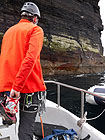
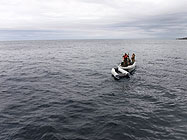
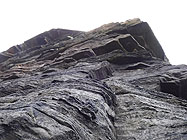
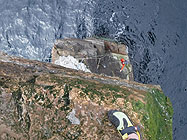
This part was pretty awkward, but the 'ledgy' nature of the sandstone makes things look a bit easier then they perhaps are. I pulled over the overhang tentatively at first, feeling out holds. Its one thing hanging around getting pumped, but I wouldn't want to rush and have a hold break on me either. While contortedly getting caught in a hollow in the overhang, I wound up sitting on this ledge with a second overhang pressing down on me, finding I could gain a comfortable position sitting in it and looking out. I could feel the pressure of the pitch pushing me down, but by this point in time I was also getting good at climbing straight through that pressure. I pulled out of my hole, went to the right (south) and felt over the lip to positive holds, pulling over without any issue. The crux was really trying not to get stuck sitting down, it seemed.
Once pulled over, I was on a ledge created by a recession of softer rock. I was well pleased. I'd done my bit, so got some photos and discovered that my pitch had been overhanging, as a stone dropped would fall straight into water.
I (again, awkwardly!) headed north around the corner of the stack, then one more easy pull brought me to ledge. The belay took a long time to make. There was little in the way of placements now, and I was reduced to using microwires. The rock was also a little soft and shattered, so in some cases I scraped out placements, took my time, and cobbled together four nuts (one full strength, three micro). Then I brought Dave up. I'd felt my pitch was HVS 5a, Dave reckoned E1 5b.
So limited was space that it was awkward to get Dave beyond me. I don't think he was best pleased that the belay seemed dodgy. I had worked long and hard to make everything optimal, but I suppose it still didn't 'look' bomber. Dave headed onto his pitch, finding gear a struggle, and moving cautiously. I still felt pretty safe and confident I could lead the whole thing, yet there was no way we could have swapped belay; space was just so constricted. The safest course of action here was for Dave to get the lead finished. He placed what seemed like token gear and spent a long time at the base of the corner.
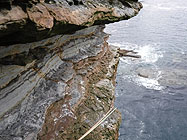
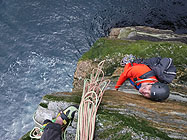
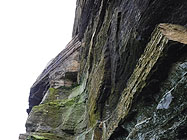
I was now getting worried, the lack of protection and fall potential was becoming an issue. Falling was a possibility now; if that happened, Dave had a couple pieces of stop him. And if they ripped? It wasn't exactly the most solid rock. We may have a 'factor two' and a monster pendulum onto my little nut belay. How much would it hurt to hit the water from 25 metres? Better than hitting the ground, I suppose.
Dave searched again; nuts just popped from their placements when pull-tested. Nothing seemed satisfactory. All options were exhausted and you could have snapped the tension with a knife. Dave began moving. He moved fast, with certainty. This was it. The blood drained from my head so much I became dizzy watching. Dave was grunting through it, slapping leftward. In a blur of motion, hands crossed over hands. He remained stuck to the rock. He didn't fall. He reached the big ledge, the crux was done and the route was in the bag.
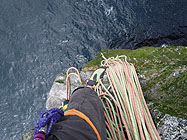
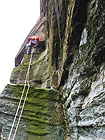
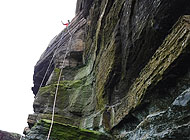
Oh, the relief. He constructed a mega anchor at this ledge, followed some short cracks then stood on the summit of North Gaulton Castle. I followed up shortly after. His lower gear seemed reasonable, but the climbing through the corner just seemed a bit awkward with holds all sloping uselessly. A couple incut crimps got me up, but it was harder than it had looked. I had to give it to Dave; a damn good lead in a hard circumstances.
The Zawadski's were back to see us to the summit, it was all waves and cheers. We took just five minutes on the summit, a wander around this improbable flat grassy place, then set up to abseil. With a BBC crew's anchor in place from some weeks back (for a programme eventually transmitted 2017) we had an easy abseil escape; an absolutely luxury compared to what we'd expected.
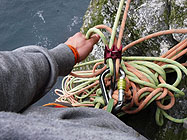
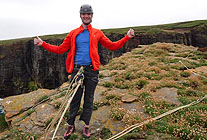
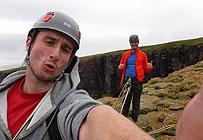
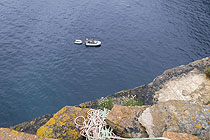
Abseil and Out
In the absence of any better information, we'd eventually settle on calling the route Solitude. It goes at about E2 5b - steady and nowhere too difficult, but certainly a bit psychological. I wonder if such a line should really have a more basic name. But 'West Arete and Groove' really is clunky. So what the heck - 'Solitude' it is.
I headed down first, past the Original Route grooves and a spitting fulmar or two. I reached the 5m ledge and Dave followed down after. I noticed that the bolt on this ledge has been chopped - not that you really need it anyway (?). Then we abseiled to the very bottom, the tide now lower to expose some platforms. We pulled ropes and flaked them. Richard approached with the boat, Dave jumped in then so did I.
What an adventure. One of the real highlights of the year.
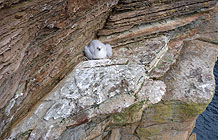
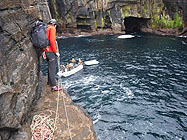
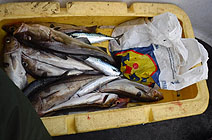
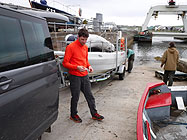
We headed back to Stromness; out on the sea Richard had the boat seemingly at full tilt. With the stack climbed and not sea sick anymore I could really enjoy this. The Sound of Hoy was a disturbing mess as we passed, the tide obviously keeps it turbulent. Will was watching the front of the boat as we kept to shallower seas and in time we rounded the corner into Stromness harbour and back to true 'terra firma'.
Our absolute gratitude goes to the Zawadski's for having us on their boat for the day, not to mention the dinner in the evening as well.
Subsequent Googling has revealed more climbing history on this stack. I collated this together on UKClimbing, to give a total of four routes including ours. Dave and I are back off to Orkney in the summer of 2017 - who knows; we might even make it back to North Gaulton Castle?
360° Panorama

North Gaulton Castle
Written: 2017-04-06